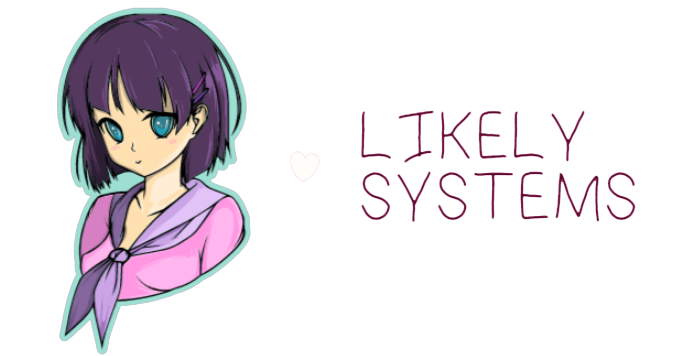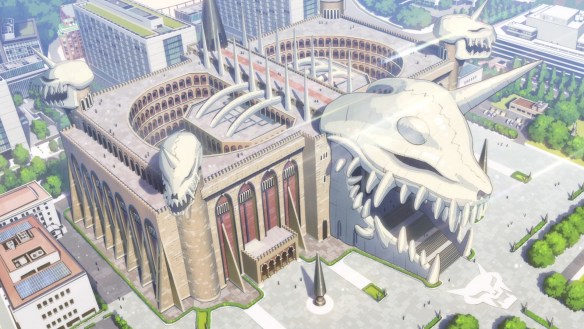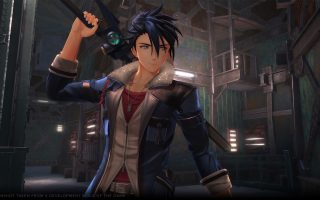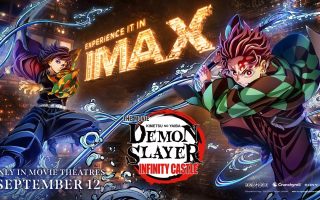Hello folks, and welcome on back to Wrong Every Time. Today I think we’ve earned some lighthearted, rip-roaring adventure, as we return to the travels of Yaiba, Sayaka, and Musashi, alongside their trusted vulture, tiger, and recently acquired frog. Having either defeated or befriended the first two of Onimaru’s eight oni minions, the team now set off for the site of a legendary clash of swordsmen, intent on learning the secrets of Yaiba’s lightning blade.
Last episode’s battle offered plenty of opportunities for Takahiro Hasui’s team to show off their dynamic animation chops, with the lightning aura of Yaiba’s uncontained weapon offering a natural compliment to this production’s angular, exaggerated posing. It also provided a few key indicators regarding this narrative’s structure and thematic intent; we’ve essentially set up a Sailor Moon-style league of villains, whose abilities echo the corrupting influence of Yaiba and Onimaru’s blades. Beyond that, Aoyama’s approach to Yaiba’s training and his introduction of new variables both seem refreshingly freewheeling; the series is proceeding with the loose, rambling energy of early Dragon Ball, and that’s a very good place to be. Let’s hop back in!
Episode 5
Onimaru’s done some truly inspired remodeling of the diet building, equipping it with giant beast skulls and a skeletal ribcage of buttresses. I appreciate how fully we’re leaning into this absurd contrast of yokai aesthetics and modern society
I suppose you gotta have a theme, and Onimaru’s clearly all-in on the skull motif. His armor features a skull chestpiece, skull pauldrons, skull knuckles, and even skull kneepads
It’s interesting how Aoyama’s not really going for any sort of intimidating design philosophy with these oni – in fact it’s rather the opposite, they’re all designed as humorous plays on generally non-threatening animals. Feels like a reflection of how shonen aesthetics have shifted over time; even Dragon Ball transitioned from playful, silly enemy designs in its original incarnation to more intimidating villains like Frieza and Cell. I suppose the audience has changed as well; this is a self-consciously lighthearted children’s production, whereas more self-serious modern shows like Jujutsu Kaisen and Demon Slayer style themselves as all-ages fare, courting an audience that would push back against the reality that they’re watching stories for children (as the backlash to stuff like Luffy’s Fifth Gear demonstrated)
“Why isn’t anyone assisting Mr. Slug?” More and more people are asking this
“To make matters worse, it appears Mr. Frog has joined the enemy.” Excellent inherent gag in Onimaru gravely inquiring about these nursery rhyme creatures
The team combines Yaiba’s “Senpuken” blade-spinning technique with a truckload of salt to defeat poor Mr. Slug. Combat is largely conducted through a series of emergent tactical revelations, whether serious (like the discovery of the Senpuken itself) or silly like this. It’s a relatively unstructured approach to conflict that’s frequently embraced by more humor-tinged shonen with less interest in gamified combat, and particularly when the protagonist is still wildly powerful relative to their usual opponents
Luffy basically embodied this style in early One Piece, defeating enemies with either playful invented maneuvers or through finding some logical counter to a given opponent (water defeating sand, rubber defeating lightning). The style becomes tougher to maintain on a longer scale, when the fights themselves start to stretch, and leaving relative strength undefined starts to undercut the weight of the proceedings. Eventually Luffy’s playful invention was complimented by the rigidity of the haki system, Gon’s lateral thinking was buttressed by the rules of nen, and even Goku’s playful combat was systematized into linear power scaling
That said, the gamified style that shonen often trend towards is far from the only, default, or “correct” approach to action in storytelling. Fantasy literature and action cinema offer countless examples of how to make physical action feel coherent and impactful, from describing great turns of battle in florid metaphor to emphasizing the physical interactions of bodies in space. LitRPG “my strength is literally a series of numbers and special attacks” may have claimed a significant degree of cultural mindshare, but its current preeminence only reflects an audience that has grown up accustomed to videogame logic
Delightful squashing and stretching as the miniaturized Mr. Slug flees from battle
And I still love the ecstatic motion of this OP’s electric clashes. Quite nice how this story’s contrast of wind and lightning naturally compliments the harsh angularity of Kaneda-style animation
Amused at how no one seems bothered by Yaiba and the gang walking down the street with a tiger and man-sized toad
“You are our one millionth customer!” Oh no, predatory street barkers, Yaiba’s only weakness
Yaiba continues his balance training at the onsen. I suppose balance is one of those areas where it’s convenient to visually demonstrate improvement over time
Musashi then introduces a tired onsen staple, attempting to peek on the girls’ bath. I don’t know who was patient zero for this Master Roshi-style “the martial arts master is a skeevy creeper” trope (Naruto has two of them!), but I suppose I at least understand it – it’s a gravitas-deflating counterpoint, adding levity and vulnerability to the allegedly wise, unimpeachable elder. Still find it to be an exhausting, unsympathetic trope, but it doesn’t seem like it’s going anywhere
Extremely good blink-and-you’ll-miss-it frames as Yaiba attempts to swim through open air, then does a Looney Tunes drop to the ground
Oh my god, I love our two latest oni, a starfish and a sea cucumber. Feels like Aoyama is intentionally making them less intimidating by the episode, and I absolutely approve
Their third ally is a mantis. Excellent background gag of the oni minions desperately slaving away in the kitchen to handle Yaiba’s appetite; so far our nefarious villains have only succeeded in offering the party a lovely vacation
This starfish has Tonpa’s nose from Hunter x Hunter. You don’t really see that design feature anymore; it’s basically a more simplified, realistic variation on Osamu Tezuka’s big noses, but big noses generally fell out of favor as we moved toward the modern era’s more sleek, minimized facial features
Lots of good faces in this episode. Sayaka gets a strong one as she quasi-admires Yaiba’s ability to consume infinite rice
Some nice color design as we jump to the requisite test of courage. Yaiba will lean on CG backgrounds where it’s convenient (like for the onsen’s interior), but it can also pull off some excellent painted backdrops
Effective boarding to lean into the horror tone as the test begins, ranging from extreme closeups that create a sense of intimate vulnerability, to shots framed through the trees and underbrush to imply a sense of surveillance and lurking predators
They play up Mantis’ powers of disguise, only for him to pull off a wildly sub-Red Riding Hood impression of an old woman. I’m quite enjoying how Dragon Ball-esque all of this is – the gags are playful and get at least as much priority as the fights, and all the characters are having a generally good time. I do miss Bulma, but sadly, shonen scientists still haven’t cracked the code of making an imitation Bulma
“He’s the nicest of the Eight Ogres. He’s an adorable little guy.” Considering how pathetic these monsters are, and how swiftly we’re munching through them, I imagine we’re up for a stakes-raising second slate of monsters whenever Onimaru gets sick of these shenanigans
Excellent contrast between the rich scene-setting of these backgrounds and expository threat buildups versus the pathetic anticlimax of each actual confrontation. It’s unsurprisingly a hard trick to pull off, but “aesthetic grandeur applied to inane comedy” is an extremely strong anime gag, one that Nichijou and City use constantly
A touching reunion as Mantis and Sea Cucumber arrive just in time to help Starfish with his final battle. Aoyama is consistently exploiting a reliable truism of side characters: it is not hard to make characters feel sympathetic if they are inherently pathetic. An alleged enemy who is pathetically attempting to do their best at villainy is very easy to turn into a sympathetic party member
Sadly, many mangaka go beyond “pathetic” in defining such characters, moving all the way into outright “obnoxious” with their passions and mannerisms. “Attempting to defeat the heroes because the boss said so” is practically value-neutral when it comes to these groundless fantasy shonens; in contrast, a preoccupation like “always leering at the female characters” or mannerism like “always talks at maximum volume” is liable to make your character outright repellant. Granted, those are the two defining qualities of Demon Slayer’s third and fourth party members, and that show’s a hit, so I suppose my preferences in character writing are far from universal ones
Yaiba retrieves his sword from the rock it’s trapped in by yanking the whole dang rock, an interesting variation on a Gordian Knot solution
“We’ll show ‘em what we’re made of!” It’s a natural instinct to root for the underdog, and that plays well off naturally, impossibly strong characters like Yaiba, Goku, or Luffy. Little wonder their stories are full of sympathetic former villains
Another strong abridged payoff short as Musashi is blasted by the three flying villains. Never underestimate the power of a perfectly cut explosion or scream
More outrageously good exaggerated smears as our three villains wake up and immediately freak out
“Lord Onimaru is so mean!” The trio are unsurprisingly overwhelmed by the kindness of our leads
Starfish wants to “go back to my wife in Kyushu, and live the quiet life.” Delightful implication that all of these anthropomorphized monsters were actually just living ordinary lives somewhere until Onimaru summoned them
Thus we are reduced to Onimaru’s final ogre, a stylish-looking vampire
And Done
Well that was some delightful nonsense! After last episode’s focus on Yaiba actually learning about both combat technique and his own destiny, this was a welcome shift to sillier fare, in spite of actually featuring the “defeat” of half of Onimaru’s nefarious forces. The three hapless hotel-hijacking ogres were clearly the stars here, demonstrating the enduring appeal of charmingly incompetent villains, and naturally slotting into our increasingly bizarre traveling party. The show also remains a visual treat, offering plenty of creative smears and a host of lushly realized new locales, alongside dynamic action posing that makes even the silliest of fights feel energetic. The rambling, lighthearted appeal of the original Dragon Ball in a polished modern package; Yaiba is a rare and much-appreciated gift.
This article was made possible by reader support. Thank you all for all that you do.




